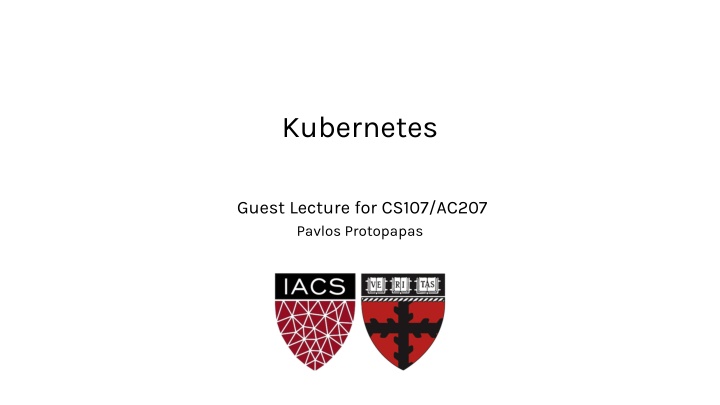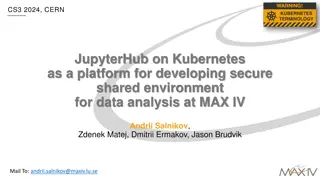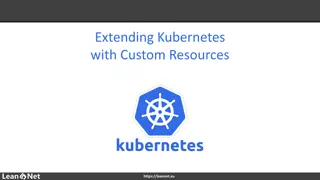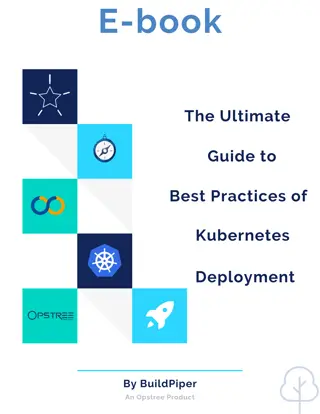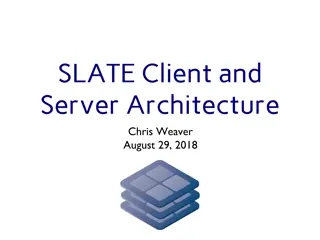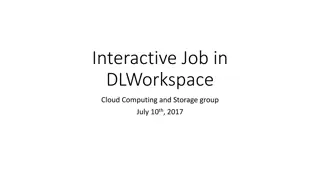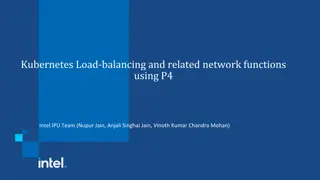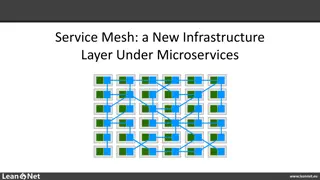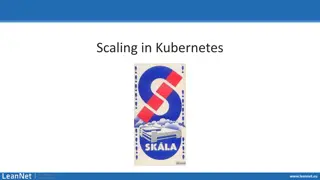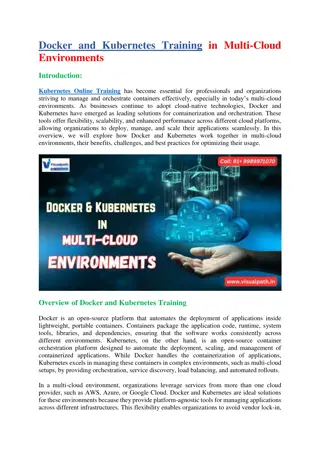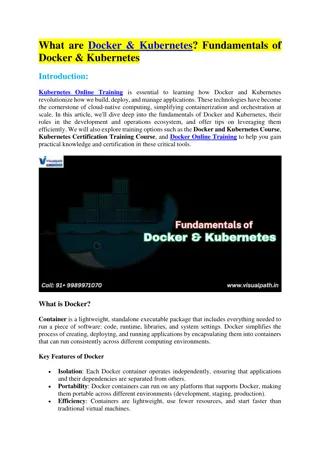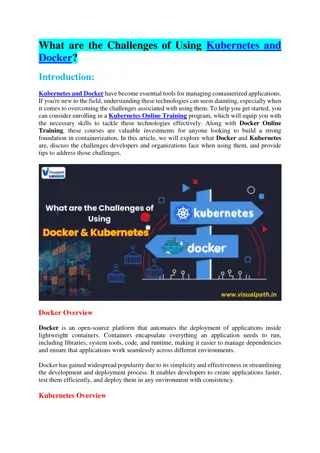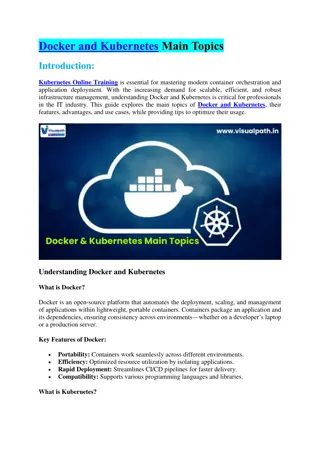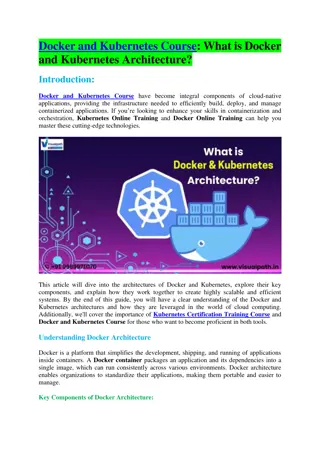Introduction to Kubernetes and Microservice Architecture in Data Science
Explore the world of Kubernetes, understand the advantages of using it, learn how to deploy a Kubernetes cluster, and delve into common kubectl commands. Additionally, discover the benefits of utilizing microservice architecture to build complex data science applications effectively.
Download Presentation

Please find below an Image/Link to download the presentation.
The content on the website is provided AS IS for your information and personal use only. It may not be sold, licensed, or shared on other websites without obtaining consent from the author.If you encounter any issues during the download, it is possible that the publisher has removed the file from their server.
You are allowed to download the files provided on this website for personal or commercial use, subject to the condition that they are used lawfully. All files are the property of their respective owners.
The content on the website is provided AS IS for your information and personal use only. It may not be sold, licensed, or shared on other websites without obtaining consent from the author.
E N D
Presentation Transcript
Kubernetes AC295 Guest Lecture for CS107/AC207 Pavlos Protopapas
Outline 1: Recap 2: Introduction to Kubernetes 3: Advantages of using Kubernetes 4: Deploying a Kubernetes Cluster 5: Common kubectl Commands Advanced Practical Data Science Pavlos Protopapas AC295
Outline 1: Recap 2: Introduction to Kubernetes 3: Advantages of using Kubernetes 4: Deploying a Kubernetes Cluster 5: Common kubectl Commands Advanced Practical Data Science Pavlos Protopapas AC295
Recap Containers Virtual Environment Virtual Machines Pros: lightweight Pros: remove complexity Cons: does not isolate from OS Pros: isolate OS guest from host Cons: intensive use hardware Cons: issues with security, scalability, and control microservices container How to manage microservices? Monolithic Advanced Practical Data Science Pavlos Protopapas AC295
Recap Advanced Practical Data Science Pavlos Protopapas AC295
Recap We talked about pros/cons of environments (removed complexity/does not isolate from OS), virtual machines (isolate OS guest from host/intensive use of the hardware), and containers (lightweight/issue with security, scalability, and control) Goal: find effective ways to deploy our apps (more difficult than we might initially imagine) and to break down a complex application into smaller ones (i.e. microservices) Issues we have fixed so far: conflicting/different operating system different dependencies "inexplicable" strange behavior Advanced Practical Data Science Pavlos Protopapas AC295
Outline 1: Recap 2: Introduction to Kubernetes 3: Advantages of using Kubernetes 4: Deploying a Kubernetes Cluster 5: Common kubectl Commands Advanced Practical Data Science Pavlos Protopapas AC295
Use Microservice Architecture to build App Microservice 1 User Interface UI Service 1 <database> Service 1 REST HTML REST Browser API Service 2 <database> Service 2 Gateway REST Service 3 <database> Mobile Device Service 3 Advanced Practical Data Science Pavlos Protopapas AC295
Kubernetes to the Rescue <K8s> K8s is an orchestration tool for managing distributed services or containerized applications across a distributed cluster of nodes. K8s itself follows a client-server architecture with a master and worker nodes. Core concepts in Kubernetes include pods, services (logical pods with a stable IP address) and deployments (a definition of the desired state for a pod or replica set). K8s users define rules for how container management should occur, and then K8s handles the rest! Advanced Practical Data Science Pavlos Protopapas AC295
How do we build it with K8s? Components & Architecture Maggie Is going to develop a cool application for AC295. She decided to use K8s to build the Online Store (?) Application <Worker Node 1> <docker> <Worker Node 2> <docker> CLI <Master Node> <kubectl> <Worker Node 3> Maggie <docker>
K8s Components & Architecture <cont> <Master Node> The master node has: API server contains various methods to directly access the Kubernetes CLI API server <kube-apiserver> etcd works as backend for service discovery that stores the cluster s state and its configuration <kubectl> Maggie etcd
K8s Components & Architecture <cont> <Master Node> Scheduler assigns to each worker node an application controller manager scheduler Controller manager: Keeps track of worker nodes Handles node failures and replicates if needed Provide endpoints to access the application from the outside world CLI API server <kube-apiserver> <kubectl> Maggie etcd
K8s Components & Architecture <cont> <Master Node> cloud cloud-controller manager provider API controller manager scheduler Cloud controller communicates with cloud provide regarding resources such as nodes and IP addresses CLI API server <kube-apiserver> <kubectl> Maggie etcd
K8s Components & Architecture <cont> <Master Node> cloud cloud-controller manager provider API <Worker Node x> controller manager scheduler <docker> pod 1 pod 2 CLI API server <kube-apiserver> container 1 container 2 container n container 1 container 2 container n <kubectl> kubelet Maggie The worker node consists of: etcd Kubelet talks to the API server and manages containers on its node
K8s Components & Architecture <cont> <Master Node> cloud cloud-controller manager provider API <Worker Node x> controller manager scheduler <docker> kube-proxy pod 1 pod 2 CLI API server <kube-apiserver> container 1 container 2 container n container 1 container 2 container n <kubectl> kubelet Maggie etcd Kube-proxy load-balances network traffic between application components and the outside world
Outline 1: Recap 2: Introduction to Kubernetes 3: Advantages of using Kubernetes 4: Deploying a Kubernetes Cluster 5: Common kubectl Commands Advanced Practical Data Science Pavlos Protopapas AC295
Advantages of using Kubernetes There are many reasons why people come to use containers and container APIs like Kubernetes: 1. 2. Scaling (of both software and teams) 3. Abstracting the infrastructure 4. Efficiency Velocity k8s API <kube-service> All these aspects relate to each other to speed up process that can reliably deploy software. User Advanced Practical Data Science Pavlos Protopapas AC295
Advantages of using Kubernetes: Velocity It is the speed with which you can respond to innovations developed by others (e.g. change in software industry from shipping CDs to delivering over the network) Velocity is measured not in terms of the number of things you can ship while maintaining a highly available service ML Application K8s K8s <nodes> API VM VM VM <kubectl> <database> <model1> <frontend> VM Advanced Practical Data Science Pavlos Protopapas AC295 Maggie <model2>
Velocity <cont> Velocity is enabled by: Immutable system: you can't change running container, but you create a new one and replace it in case of failure (allows for keeping track of the history and load older images) K8s <nodes> VM VM VM <database> <model_v2.0> <frontend> VM <model_v1.0> Advanced Practical Data Science Pavlos Protopapas AC295
Velocity <cont> Velocity is enabled by: Declarative configuration: you can define the desired state of the system restating the previous declarative state to go back. Imperative configuration are defined by the execution of a series of instructions, but not the other way around. K8s <nodes> YAML <app.yaml> 2 database 1 model 1 frontend VM VM VM VM <database> <database> <model_v1.0> <frontend> Advanced Practical Data Science Pavlos Protopapas AC295
Velocity <cont> Velocity is enabled by: Online self-healing systems: k8s takes actions to ensure that the current state matches the desired state (as opposed to an operator enacting the repair) K8s <nodes> YAML <app.yaml> 2 database 1 model 1 frontend VM VM VM VM <database> <database> <model_v2.0> <frontend> VM < database > Advanced Practical Data Science Pavlos Protopapas AC295
Advantages of using Kubernetes: Scaling As your product grows, it s inevitable that you will need to scale: Software Team/s that develop it Advanced Practical Data Science Pavlos Protopapas AC295
Scaling Kubernetes provides numerous advantages to address scaling: Decoupled architectures: each component is separated from other components by defined APIs and service load balancers. Easy scaling for applications and clusters: simply changing a number in a configuration file, k8s takes care of the rest (part of declarative). Scaling development teams with microservices: small team is responsible for the design and delivery of a service that is consumed by other small teams (optimal group size: 2 pizzas team). Advanced Practical Data Science Pavlos Protopapas AC295
Scaling <cont> Microservice 1 API Container 1 Team Maggie LOAD BALANCER Microservice 2 API Container 2 Team John Advanced Practical Data Science Pavlos Protopapas AC295
Scaling <cont> Kubernetes provides numerous abstractions and APIs that help building these decoupled microservice architectures: Pods can group together container images developed by different teams into a single deployable unit (similar to docker-compose) Other services to isolate onemicroservice from another such (e.g. load balancing, naming, and discovery) Namespaces control the interaction among services Ingress combine multiple microservices into a single externalized API (easy-to-use frontend) K8s provides full spectrum of solutions between doing it the hard way and a fully managed service Advanced Practical Data Science Pavlos Protopapas AC295
Scaling <cont> Advanced Practical Data Science Pavlos Protopapas AC295
Advantages of using K8s: Abstracting your infrastructure Kubernetes allows to build, deploy, and manage your application in a way that is portable across a wide variety of environments. The move to application-oriented container APIs like Kubernetes has two concrete benefits: separation: developers from specific machines portability: simply a matter of sending the declarative config to a new cluster Advanced Practical Data Science Pavlos Protopapas AC295
Advantages of using K8s: Efficiency There are concrete economic benefit to the abstraction because tasks from multiple users can be packed tightly onto fewer machines: Consume less energy (ratio of the useful to the total amount) Limit costs of running a server (power usage, cooling requirements, datacenter space, and raw compute power) Create quickly a developer s test environment as a set of containers Reduce cost of development instances in your stack, liberating resources to develop others that were cost-prohibitive Advanced Practical Data Science Pavlos Protopapas AC295
Outline 1: Recap 2: Introduction to Kubernetes 3: Advantages of using Kubernetes 4: Deploying a Kubernetes Cluster 5: Common kubectl Commands Advanced Practical Data Science Pavlos Protopapas AC295
Deploying a Kubernetes Cluster To deploy your cluster you must install Kubernetes. In the exercise you are going to use minikube to deploy a cluster in local mode. After installing minikube, use start to begin your session creating a virtual machine, stop to interupt it, and delete to remove the VM. Below are the commands to execute these tasks: $ minikube start $ minikube stop $ minikube delete Advanced Practical Data Science Pavlos Protopapas AC295
Deploying a Kubernetes Cluster You can easily access the Kubernetes Client using the following command: to check your cluster status use: $ kubectl get componentstatuses and should see output below: Advanced Practical Data Science Pavlos Protopapas AC295
Deploying a Kubernetes Cluster You can easily access the Kubernetes Client using the following command: to list the nodes in your cluster use: $ kubectl get nodes and should see output below: Advanced Practical Data Science Pavlos Protopapas AC295
Outline 1: Recap 2: Introduction to Kubernetes 3: Advantages of using Kubernetes 4: Deploying a Kubernetes Cluster 5: Common kubectl Commands Advanced Practical Data Science Pavlos Protopapas AC295
Common kubectl Commands Let s practice Kubernetes! Useful commands to complete the exercise: $ kubectl create -f app-db-deploymnet.yaml $ kubectl get deployment $ kubectl get pods $ kubectl get pods / -o=custom-columns=NAME:.metadata.name,IP:.status.podIP $ kubectl create -f app-server-deploymnet.yaml $ kubectl expose deployment / app-deployment --type=LoadBalancer --port=8080 $ kubectl get services $ kubectl delete service app-deployment $ kubectl delete deployment app-server-deployment $ kubectl delete deployment app-db-deployment Advanced Practical Data Science Pavlos Protopapas AC295
THANK YOU Advanced Practical Data Science Pavlos Protopapas AC295
